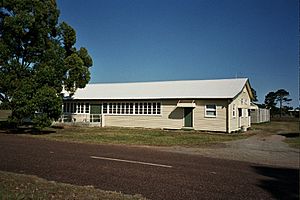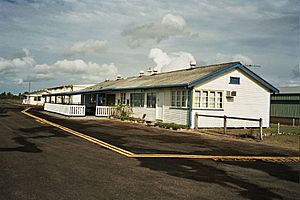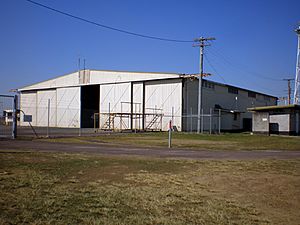Second World War RAAF Buildings, Maryborough Airport facts for kids
The Second World War RAAF Buildings are a special group of old air force buildings. They are located at Marywater Creek Road at Maryborough Airport in Queensland, Australia. These buildings were constructed between 1941 and 1944 during World War II. They are now protected as a heritage site, added to the Queensland Heritage Register in 2007.
Quick facts for kids Second World War RAAF Buildings, Maryborough Airport |
|
|---|---|

Second World War RAAF Buildings, 2005
|
|
| Location | Saltwater Creek Road, Maryborough, Fraser Coast Region, Queensland, Australia |
| Design period | 1939 - 1945 (World War II) |
| Built | c. 1941 - c. 1944 |
| Official name: Second World War RAAF Buildings, Maryborough Airport | |
| Type | state heritage (built) |
| Designated | 23 March 2007 |
| Reference no. | 602556 |
| Significant period | c. 1941-c. 1944 (fabric) 1941-1946 (historical) |
| Significant components | hut/shack, store/s / storeroom / storehouse, garage, office/administration building, latrine, hangar, trees/plantings, hospital |
| Lua error in Module:Location_map at line 420: attempt to index field 'wikibase' (a nil value). | |
Contents
A Look Back: Maryborough's Wartime Airport
The buildings at Maryborough Airport were built in the early 1940s. They were part of a military airfield for the Royal Australian Air Force (RAAF). This base helped train aircrew for the war. After the war, the Maryborough City Council turned it into a regular airport. Some of these old buildings are still used today.
Maryborough's Role Before the War
Maryborough was an important town in Queensland. It started in the 1840s to supply sheep farms. Later, it became a busy port for gold, timber, and sugar. It grew into a major regional center with factories and industries. Before World War II, Maryborough already had a small airport for regular flights.
Training Airmen for War
In 1938, as war seemed likely, Australia started building up its air force. A big air base was set up at Amberley in Queensland. After World War I, people realized how important air power would be in future wars. When World War II began in 1939, it was urgent to build planes and train pilots and aircrew.
Britain couldn't train all the aircrew needed for the war. So, the Empire Air Training Scheme (EATS) was created in December 1939. This was an agreement between Britain, Canada, Australia, and New Zealand. Aircrews would be trained in these countries to serve with the Royal Air Force. Australia agreed to train 28,000 people over three years, and eventually trained about 37,000 airmen.
All Australian trainees started their training in Australia. Most finished their training there, while some went overseas for advanced training. They then joined squadrons fighting in Europe, North Africa, and the Pacific. The EATS scheme used 49 airfields in Australia. In Queensland, EATS units were at Amberley, Archerfield, Bundaberg, Kingaroy, Maryborough, and Sandgate. Maryborough was chosen to train Wireless Air Gunners and Air Navigators.
Building the Air Base
The RAAF took over the Maryborough site in December 1940. The existing airfield was too small, so more land was bought to make longer runways and add facilities. The new airfield covered about 355 acres. It included the old civil airport, land owned by the city council, and land from 15 private owners. Some of this land already had a sawmill, a service station, and dairies.
A lot of money, about £257,928, was set aside for buildings, construction, and equipment. By April 1941, land was being cleared, and runways and buildings were being built. The training school opened on September 18, 1941. The first group of trainees arrived on November 16, even though construction was still going on.
War in the Pacific
On December 7, 1941, the United States joined the war after Japan bombed American ships at Pearl Harbor. The EATS scheme was paused to see how this new threat to Australia would change things. However, Australia didn't have many planes. In February 1942, it was decided to continue the scheme. Enough aircrew would stay in Australia to fly planes in the Pacific. Some experienced aircrew were also called back.
Many Australian and American soldiers came to Queensland. Plans for defending Australia and fighting in the Pacific were quickly put into action. It was hard to find enough materials, services, and workers locally. Queensland had a small population and no heavy manufacturing like the southern states.
The first buildings built were "P" series huts. These were pre-cut timber and iron buildings put together on site. Three of these huts are still at Maryborough. Later, a plan was made to build parts in the south, ship them, and assemble them where needed. Designs also considered the lack of workers and some materials. Bellman aircraft hangars were examples of these prefabricated buildings. Two Bellman hangars were built at Maryborough.
The war in the Pacific quickly got worse. Japan attacked the Philippines and Singapore. Darwin was bombed on February 19, 1942. About 14,000 Australians were captured when Singapore fell in February 1942.
Training Recruits and Women
From April 1942, Maryborough also started training new recruits. No 3 Recruit Depot operated there until July 1943. No 6 Recruit Depot was there from November 1944 to June 1945. These units gave basic training to about 4000 recruits. Women from the Women's Auxiliary Australian Air Force (WAAAFs) were also stationed at Maryborough.
As the air war moved north, so did the main air bases. The Battle of the Coral Sea happened in May 1942, and the Battle of Midway in June 1942. Japanese troops landed in Papua New Guinea in July 1942. Hospitals at airfields were prepared to receive wounded soldiers.
Maryborough airfield was also used for repairing aircraft. A third and fourth Bellman hangar were built there in 1944. However, on August 15, 1944, it was decided to close the Wireless Air Gunner School at Maryborough. Wireless Operators would instead be trained at Ballarat. The base facilities were then used by RAAF 1 Radar School. The training school closed on December 6, 1944.
After the War
After the victory in Europe in May 1945, the Royal Navy formed the British Pacific Fleet. In June 1945, a unit called HMS Nabstock arrived in Maryborough. This was a mobile naval air base (MONAB). It was used for training crew and assembling aircraft for the British Pacific Fleet. Several Royal Navy Air Squadrons were based in Maryborough until late 1945. The RAAF station closed after the last of these units left in November 1945.
After the war ended, control of the airfield went to the Department of Civil Aviation on July 31, 1946. At its busiest, there were 127 buildings on site. All buildings not needed for civil aviation were removed. Civil Aviation decided to keep the hospital, motor transport garages, two hangars, a flight office, a workshop, a store, an inflammables store, and two latrines. One of the hangars was later removed, but most of the chosen buildings are still there.
Some concrete slabs and other signs of the old RAAF buildings can still be seen around the airport. The runways have been redone, and a third cross strip from the war is gone. The tree-lined entrance road is still the main way to get to the airport.
Today, the Fraser Coast Regional Council owns and runs the airport. It is a busy civil airport used by private planes, charter flights, crop dusters, and maintenance companies. The Maryborough Aero Club also uses it.
What You Can See Today
The Maryborough Airport is located northwest of the city center. It has two runways. The main runway is paved with bitumen and is 1587 meters long. The grass cross strip is 885 meters long.
There are trees along the entrance road. It's not known if any of these trees were planted during the war. To the left of the drive is an open area. To the right, you can see a row of buildings from World War II. These include:
- Building A: This was the former inflammables store. It's a small, square building on a concrete slab. It has a hipped roof made of corrugated iron with a large vent on top. It's now used for storage.
- Building B: This was the former Motor Transport Garage. It's a rectangular building with a skillion roof. Its walls and roof are made of corrugated iron. It has six narrow roller doors on one side. It also has casement windows, some with metal sunhoods. It is now used for storage.
- Building C: This building was a set of latrines (toilets). It's a rectangular building made of corrugated iron on a concrete slab. It has a gabled roof. There's a narrow band of glass louvres below the roof's edge.
- Building D: This is an adapted P1 hut. It was the former Hospital or Sick Quarters. It's now used for community activities. It's a rectangular building on low stumps, covered in horizontal corrugated iron. It has a gabled roof. What used to be a wide front verandah is now enclosed with windows. There's also an extension at the back. Metal canopies with scalloped edges are over the doors.
- Building E: This is also a P1 hut. It was once used as a parachute-packing shed. It is now the airport terminal. It has been changed a bit for this purpose, including adding a covered baggage area.
North of the terminal, near the edge of the tarmac, are:
- Building F: This is a Bellman aircraft hangar. It's a prefabricated building made of galvanized iron with a concrete floor. It has a low-pitched gabled roof and large sliding doors that run along tracks at the front.
- Building G: This is another P1 hut and is probably the most original. It has a wide verandah facing the runways. It was formerly a Flight Office and is now used by the Maryborough Aero Club.
Why These Buildings Are Important
The Second World War RAAF Buildings at Maryborough Airport are important because they show how aircrew were trained during World War II. Aircrew trained here served in many parts of the world. The base also trained naval pilots for the British Pacific Fleet.
The Bellman hangar and the field hospital are now rare examples of their type still in their original locations in Queensland.
Even though many buildings from the war are gone, the ones that remain show what kind of buildings were needed for a wartime air base. These include a hangar, flight office, hospital, parachute packing shed, garage, store, and latrines. Together with old war records, these buildings help us understand how the airfield worked during the war.



